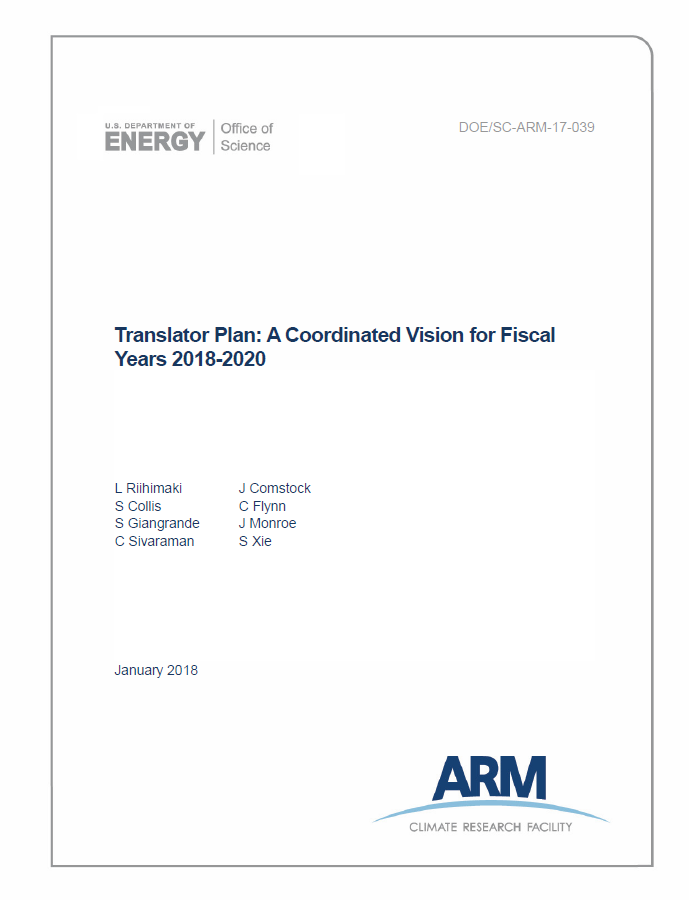Priorities Set for ARM Translators in New Three-Year Vision
Published: 18 February 2018

Translators serve a unique role within the ARM Climate Research Facility, directing the creation of value-added products (VAPs) and analysis tools to make ARM measurements more accessible to a broader swath of the scientific community.
Translators also serve as liaisons between science users and ARM infrastructure staff members, collecting information about scientific priorities and communicating details about ARM data and services to users.
As the ARM Facility’s needs have changed, so have the priorities of ARM’s Translator Group.
In June 2017, the group began work on a three-year vision plan to incorporate key feedback and align with ARM’s mission priorities.
“Most new product development cycles are longer than one year, so if you think a little bit farther down the road, you have a chance to be a bit more strategic and coordinated,” says Laura Riihimaki, ARM data products and translators lead from Pacific Northwest National Laboratory (PNNL).
Building a Foundation

To develop the “Translator Plan: A Coordinated Vision for Fiscal Years 2018-2020,” Riihimaki and four other ARM translators worked with representatives from the ARM Data Quality Office and software development, as well as ARM Engineering and Process Manager Jennifer Comstock, who provided input and direction from ARM Facility priorities.
Members of the multi-institutional Translator Group are:
- Riihimaki, Comstock, Connor Flynn (aerosol translator), and Krista Gaustad (software development), PNNL
- Scott Collis (Python ARM Radar Toolkit/precipitation radar translator), Argonne National Laboratory
- Scott Giangrande (cloud radar/sonde translator), Brookhaven National Laboratory
- Justin Monroe (ARM Data Quality Office VAP lead), University of Oklahoma
- Shaocheng Xie (modeling translator), Lawrence Livermore National Laboratory.
PNNL’s Chitra Sivaraman (software development) also contributed to the vision plan.
The Translator Group considered feedback from the ARM User Executive Committee (UEC), which serves as the official voice of the user community in its interactions with ARM management, and the ARM Triennial Review that took place in April 2017. It also reviewed priorities from the Large-Eddy Simulation (LES) ARM Symbiotic Simulation and Observation (LASSO) project, new instrumentation and activities as described by ARM Technical Director Jim Mather, and working groups and principal investigators with the U.S. Department of Energy’s Atmospheric System Research (ASR) program.
“In the past, each translator was aligned very closely with an ASR working group, so we would be developing products primarily for that working group and working almost exclusively with one group,” says Riihimaki, an atmospheric scientist at PNNL. “As the new ASR working group structure has been put together, and as ARM widens its user base, that didn’t mesh as nicely as it did in the past. Instead, we’re really trying to produce cross-cutting products that are being used by multiple ASR working groups and other members of the user community.”
Areas of Focus
Based on the feedback it received, the Translator Group decided to prioritize work in the following five areas from 2018 to 2020:
- tools and products to facilitate use of ARM data by modelers, including LASSO and the earth system modeling community
- producing core VAPs for ARM Mobile Facility (AMF) deployments
- creating data products to facilitate use of new instrumentation, including Aerosol Observing System instruments, radars, lidars, and radiometers
- uncertainty assessment of strategic measurements
- improving and communicating data quality of those strategic measurements.
In its plan, the group responded to feedback that it was trying to do too much.
“One of the recommendations from the UEC was to focus on a smaller set of core and high-priority VAPs, to focus more on data quality and uncertainty, and to shift away from doing so many new higher-order retrievals,” says Riihimaki.
The Translator Group also heard that it should focus on providing a timeline for producing core VAPs from AMF field campaigns and supporting key aspects of the ARM Decadal Vision.
Motivated by Quality
To get a sense of what it could reasonably accomplish during a three-year period, the Translator Group looked at its achievements from 2014 to 2016. Those highlights included the release of 20 new evaluation or production data sets to the ARM Data Center for use by the scientific community, development on 11 new VAPs, and minor updates to more than 25 VAPs.
“I wanted to understand the life cycle of how long it takes to produce a new product, and what’s a realistic load—how many new things can we take on in a year,” says Riihimaki.
While those numbers might be helpful in maintaining balanced workloads among the translators, quality—not quantity—is at the heart of the vision plan. Responding to user feedback on the data they use and the context in which they need information about uncertainty or data quality will be crucial, along with getting robust products out quickly for new sites and field campaigns.
“We are prioritizing more consistency and focus on the products that everybody trusts and are core to the science that has to get done,” says Riihimaki.
The ARM Climate Research Facility is a DOE Office of Science user facility. The ARM Facility is operated by nine DOE national laboratories.
Keep up with the Atmospheric Observer
Updates on ARM news, events, and opportunities delivered to your inbox
ARM User Profile
ARM welcomes users from all institutions and nations. A free ARM user account is needed to access ARM data.


















